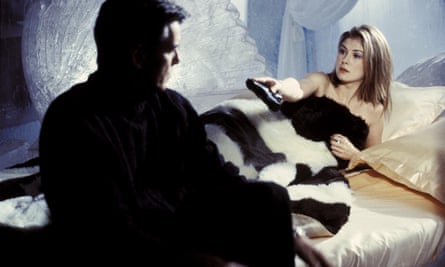There’s a scene in the 20th Bond movie, Die Another Day, when Pierce Brosnan’s 007 saunters into the black marbled lobby of a smart Hong Kong hotel, having – in 27 short minutes – already surfed into North Korea, hijacked an arms dealer’s helicopter, blasted through the DMZ on a hovercraft, been captured and tortured for 14 months, returned to MI6 in a prisoner exchange, faced a heart attack and jumped off a boat into the South China Sea.
The usually soigné secret agent is dishevelled, with long hair and a beard, his luxuriously hairy chest exposed by the open shirt of his drenched blue pyjamas. He requests his usual suite, and a bottle of ’61 Bollinger. The club manager asks if he’s been busy. “Surviving,” answers Bond, “just surviving”.
This arch juxtaposition of rags and riches exemplifies the wider tonal inconsistency of a film that, for all Bond’s talk of survival, nearly killed the franchise. Often derided as one of the series’ worst, resulting in a Daniel Craig-fronted overhaul with Casino Royale in 2006, Die Another Day has a lot to answer for: the invisible car, sliding like clear jelly through a misty ice palace; Madonna’s jerkily awful theme song; Madonna, again, playing a corseted fencing instructor; a villain who changes race; another whose face is speckled with diamonds; an estimated $70m (£59m) spent on product placement; John Cleese.
And yet, as the much-maligned first Bond movie of this century turns 20, its deranged atonality deserves a second look. It wasn’t poorly received when it came out, grossing $430m (£365m) worldwide, making it the highest-grossing Bond movie at the time. Critics were lukewarm, even if Michael Gove did approvingly call Rosamund Pike a “tart citrus sorbet”. Die Another Day was released just over a year after 9/11, and is perched uneasily between two action movie eras: the suave glamour and glossy heroics of the previous Bonds and the gritty seriousness and complex geopolitics of the next generation. It’s the most anxious of all the Bonds, and for that, I adore it.
On 11 September 2001, the creative team of Die Another Day were in a script meeting at 138 Piccadilly when they heard of the terrorist attacks on the Twin Towers, director Lee Tamahori recalled. The film’s New York-set finale was swiftly canned, and the explosive ending relocated to Korea’s Demilitarised Zone. The film’s only veiled reference to 9/11 is M’s loaded comment to Bond after his 14-month absence: “While you were away, the world changed.”
Die Another Day is both of the new world and the old. In post-9/11 action movies, heroes were cynical and fallible. They bore emotional and physical scars, often explored in origin stories (Batman Begins, and, of course, Casino Royale). Government agencies weren’t always the good guys (the Bourne movies). There are elements of this ambivalence in Die Another Day – in the movie’s surprisingly dark opening, the villain, Colonel Moon, drawls that he “majored in western hypocrisy” at Oxford and Harvard. Bond is an “assassin”, while a North Korean general is portrayed as a loving, wronged father with a strong moral compass. Bond is betrayed, imprisoned and tortured – scenes spliced horribly with the writhing fire and ice maidens of the opening credits – before a bleak, Dostoevskian moment when a desolate Bond thinks he’s going to be executed. His American saviour scoffs, “You’d think he was some kind of hero.”
So far, so complex, but then the movie shifts gears into reverse – around the time Bond walks into that hotel. Minutes later, having disarmed the masseuse, Peaceful Fountains of Desire, been reunited with his Brioni shirts and Bollinger, Bond is off to Cuba, where he meets Halle Berry’s bikini-clad Jinx, who emerges in a homage to Dr No’s Ursula Andress from the sea, squirming in slow-motion delight. It’s one of a number of self-referential winks, which range from cheeky throwbacks, like Rosa Klebb’s shoe in Q’s lab, to a metatextual commentary on the Bond universe’s increasing obsolescence with a villain who models the sneering pomposity of his white alter ego on 007 himself.
The 20th Bond movie jokes about its irrelevance, but it’s also very, very worried about being irrelevant. Die Another Day doubles down on the Bond formula – lasers, diamonds, an improbably located final bonk – while lassoing in incongruent features of the movie’s perceived competition. In an effort to keep up with the twin threats of The Matrix and video games, Tamahori insisted, in a Bond movie first, on using CGI – resulting in a truly dismal tidal-wave kite-surfing sequence widely slammed by critics. More bizarre is the film’s humour – like Jinx’s embarrassing “Your momma” crack (penned by Berry herself) – the clunkiness of which is more Austin Powers than James Bond, perhaps stemming from a fear that the Bond parody might steal Bond proper’s audience.
And then there’s a more intriguingly voiced climate anxiety. It comes in a gag: “global warming, it’s a terrible thing”, sneers Colonel Moon (Toby Stephens), as he blasts Iceland’s frozen landscape with a space laser, causing an ice sheet to crumble into the sea. The laser is named Icarus, a sly reference to the tragic consequences of man’s attempt to conquer nature. In Die Another Day – and earlier Bond movies – elemental destruction is collateral damage in man’s grander scheme for money and power.
The thing about Bond is that times change but Bond, by design, has to stay the same. So, on its 20th birthday, in times as anxious, spare a thought for this basket case of a Bond movie: faced with cultural, social and geopolitical change, 007 got a little lost. Unable to commit to recreating the Roger Moorean high camp of the films of old or to paving the way for the salty darkness of the future, Die Another Day attempted a version of both, its insecurities all too apparent – despite the invisible car.

